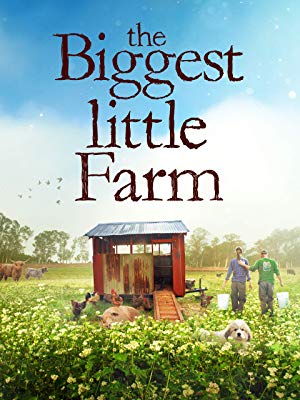Reviewed by Valentine McKay-Riddell
John Chester’s heart-warming documentary is worth not one but several viewings. Spectacular videography, beautifully articulate narration, well-crafted and delightful cartoon sequences, and a flawless musical score are icing on this cake—a story that pays homage to the resilience of the human spirit.

The film opens with a shot of the Paradise wildfire. Just when you think it’s going to be a disaster, the scene flips to sunny southern California. It’s 2010 and life partners John and Molly Chester are living in a pleasant Santa Monica apartment. John is a global cameraman and Molly an organic chef. During a photo shoot at the home of a dog hoarder, John discovers an irresistible puppy. He and Molly adopt him, naming their fur-child Todd. Unfortunately, Todd misses his new parents when they leave for work and barks all day—every day. Eventually the couple and the dog are evicted. They realize that moving to a new apartment will simply be a repeat scenario. So rather than mourn this turn of events, they decide to do what would be best for Todd and pour their collective talents into a fully organic farm – a farm “in harmony with nature,” a farm where Molly “can grow everything she could ever imagine to cook.” This is not an easy undertaking for either of them, despite a surplus of enthusiasm and creativity. For a venture as all-encompassing as this they need support—financial and professional—and by the grace of all that’s worthy they find both.
Encouraged by family members and friends, and supported by a few serious investors, John and Molly buy a large piece of land about an hour north of Los Angeles—surrounded by monoculture farms on all sides, including one defunct chicken hatchery. The land is a mess. Over-planted, depleted, the soil is dry, gray, and dead. But they soon meet Alan York, an expert consultant on traditional farming with a slow Southern accent, who encourages them to think of farming as a way of “emulating natural ecosystems.” Shortly afterwards they’re joined by experienced farm workers Flavio and Raoul (who grew up on his family’s farm in Mexico), as well as young people from all over the world with a taste for adventure. Under Alan’s guidance they acquire many animals, including chickens and ducks, sheep, cattle, two Great Pyrenees puppies, and a pregnant pig named Ugly Betty (immediately renamed Emma) who gives birth to 14 piglets! The animals’ manure will help bring the soil back to life. They create an aquifer-fed pond and stock it with fish. Though it’s not “like surfing,” as Alan suggests, Apricot Lane Farms is up and running in only one year.
The rest of the film takes us through the next eight years of the farm’s life. Triumphs abound. The production and sale of 75 varieties of stone fruit and a thriving chicken, duck, and goose egg business provide them with enough income to keep going. Wildlife returns to the land, and while this is its own kind of triumph there are challenges as well—coyotes discover the poultry shed and decimate the chickens and ducks. Alan is diagnosed with cancer and unable to be as actively involved as he was earlier; and Emma the pig, exhausted and sick with mastitis after birthing so many piglets, seems to be on her way out.
John begins to experience a kind of “slow disillusion—intent alone is not protection.” But life is a seesaw with regular ups and downs. Bees return and the fruit orchards thrive—and starlings destroy 70% of the fruit. Gophers begin to eat the roots of the trees. Snails devour the leaves of the citrus plants. Severe drought looms—the worst since 1200—and toxic algae fill the shrinking pond. Greasy the Rooster moves into the pig pen, giving Emma new purpose—and one of the Great Pyrenees dogs eats Greasy. Alan dies. Molly feels abandoned and John is heartbroken and angry.
Yet in the midst of this series of setbacks, John begins to notice how calmly Todd views the world, adjusting his behavior accordingly, and decides to do the same. Got snails? Ducks love snails—turn the ducks loose in the citrus orchard! Get more cattle. More cattle equal more manure, more manure means healthier ground cover, and besides, chickens eat fly maggots. Gophers are the natural prey of owls, so…build owl nests! This combination of observation and creative response works. In the fifth year, when 18 inches of rain bring floods and their neighbors’ topsoil washes out to sea, Apricot Lane Farms’ aquifer is replenished and its soil saved by the cover crop. More natural enemies of pests arrive: hawks, gopher snakes, more coyotes—and of course, there’s the Great Pyrenees dog Rosie, who guards the chickens, ducks, and geese. Even the drought-driven wildfires pass them by, saved by a shift in wind direction.
John and Molly, who now have a young son, realize that with all of its ups and downs, they are living their dream. Todd has led them to “the interconnected beauty that surrounds us, to a world alive with infinite possibilities and a comfortable level of disharmony—and the ecosystem of our entire planet works the same way.”
The Biggest Little Farm is a testimony to the power of intention, creativity, and commitment. Whether you’re a backyard urban farmer or someone whose houseplants are struggling to stay alive, this film is one you won’t want to miss.